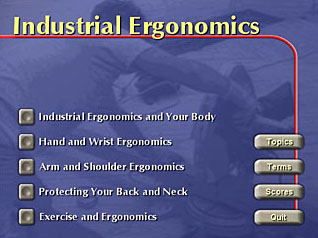Back to Course List
Ergonomics: Industrial Ergonomics

- Product ID
- smaxierg
- Training Time ?
- 30 to 45 minutes
- Language(s)
- English
- Video Format
- Standard Definition
- Required Plugins
- MasteryNet Player
- Lesson Interactions
- 14
- Quiz Questions
- 21
- Closed Captioning



Overview
This training presents the fundamentals of good ergonomic practices and helps remind employees of ergonomic problems that can occur in their jobs, as well as what can be done to address these problems.
![]() This course is in the Advantage™ format, to read about Advantage™ features click here.
This course is in the Advantage™ format, to read about Advantage™ features click here.

- Install on any SCORM LMS
- Rich multimedia presentation with interactions and quiz
- Print certificate and wallet card
- You have 30 days to complete the course
Workplaces
Categories
Audience
Training for all industrial employees.
Topics
The course presents the following topical areas:
- Ergonomics Overview and Physical Systems
- Controlling Ergonomic Stressors
- Hand and Wrist - General Positions
- Hand and Wrist - Using Tools
- Arm and Shoulder - Problem Positions
- Maintaining Neutral Arm and Shoulder Positions
- Back and Neck - Potential Problem Areas
- Back and Neck - Ergonomically Proper Positions
- Exercise and Ergonomics
Intended Performance Outcomes
Upon successful completion of this course you will be better prepared to:
-
Identify the basic principles of ergonomics.
- Describe an example of a mechanical system in the human body.
- Identify the main causes of ergonomic problems.
- Describe ways of avoiding ergonomic problems.
-
Apply ergonomic principles to avoid injuries to the hands and wrists.
- Identify specific hand and wrist movements that can create ergonomic stress.
- Identify tool-related ergonomic problems that can affect the hand and wrist.
- Describe techniques to avoid tool-related ergonomic problems.
-
Apply ergonomic principles to avoid injuries to the arms and shoulders.
- Identify positions that cause stress to the arm and shoulder.
- Describe situations that can result in ergonomic problems for arms and shoulders.
- Identify techniques to avoid ergonomic injuries to arms and shoulders.
-
Apply ergonomic principles to avoid injuries to the back and neck.
- Identify positions that cause stress to the back and neck.
- Describe techniques to avoid ergonomic problems with the back and neck.
- Describe proper lifting and carrying techniques.
-
Perform exercises to help reduce ergonomic injuries.
- Identify the role of exercise in reducing ergonomic injuries.
- Identify exercises that can be performed throughout the work day.
© Mastery Technologies, Inc.



